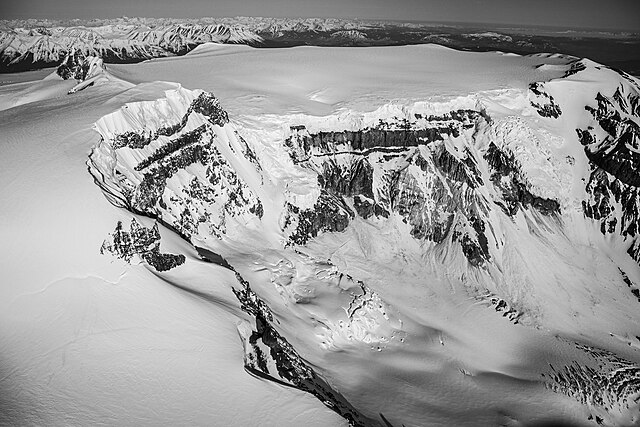Mount Edziza, sometimes called Edziza Mountain or Edziza Peak, is a stratovolcano in Cassiar Land District of northwestern British Columbia, Canada. It is located on the Big Raven Plateau of the Tahltan Highland which extends along the western side of the Stikine Plateau. The mountain has an elevation of 2,786 metres, making it the highest volcano of the Mount Edziza volcanic complex. However, it had an elevation of at least 3,396 metres before its original summit was likely destroyed by a violent, climactic eruption in the geologic past. Mount Edziza contains several lava domes, cinder cones and lava fields on its flanks, as well as an ice cap that is characterized by several outlet glaciers stretching out to lower altitudes. All sides of the mountain are drained by tributaries of Mess Creek and Kakiddi Creek which are situated within the Stikine River watershed.
The ice-filled summit crater of Mount Edziza
Glacier of the Mount Edziza ice cap
The Stikine River drains Mount Edziza via tributaries that originate from the volcano
Mount Edziza as seen from Mount Glenora in the northwest
Mount Edziza volcanic complex
The Mount Edziza volcanic complex is a group of volcanoes and associated lava flows in northwestern British Columbia, Canada. Located on the Tahltan Highland, it is 40 kilometres southeast of Telegraph Creek and 85 kilometres southwest of Dease Lake. The complex encompasses a broad, steep-sided lava plateau that extends over 1,000 square kilometres. Its highest summit is 2,786 metres in elevation, making the MEVC the highest of four large complexes in an extensive north–south trending volcanic region. It is obscured by an ice cap characterized by several outlet glaciers that stretch out to lower altitudes.
The northern half of the MEVC as seen from the southern end of the Big Raven Plateau. Cocoa and Coffee craters are at left and right centre, respectively. Ice Peak is at upper right centre while Mount Edziza itself is at upper centre.
Buckley Lake with Mount Edziza in the background
The Stikine River drains the MEVC via tributaries that flow adjacent to the volcanic complex.
Alpine tundra of the MEVC







